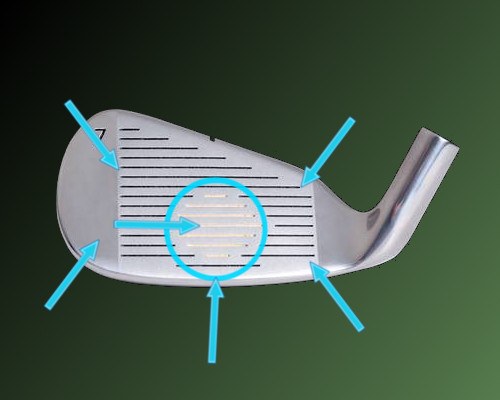
In this video swing tip we are going to discuss the information that you can get from looking at the markings on the club face and sole of your club head.
This information can provide you with valuable evidence about what is happening during impact and understanding what the markings mean can help you to diagnose your golf swing and what to improve to achieve straighter, longer and more consistent golf shots.
If you look at the club face of your golf club, you will see that there are marks left on it from where the club head impacts with the golf ball. When you swing the club head and strike the golf ball with it you want to get the middle of the club face, or the sweet spot to strike the ball. The sweet spot is about the size of a medium coin and shots struck from this area will give you maximum distance and accuracy. For every quarter inch that the strike happens away from the sweet spot you lose 10% of the distance that you could have achieved. The further away the strike is from the sweet spot, the less accurate your shot will be due to 'gear effect'. Gear effect is where the club face twists due to an off centre strike.
If you look at your club face and notice that the majority of strike marks are from the toe area of the club, this end of the club will be slowed down due to the area striking the golf ball. However, the heel area of the club face will continue to travel at the higher speed and the club face will twist, resulting in it aiming right and the golf ball being hit to the right. Similarly, if the strike marks can be seen more towards the heel of the club head, this end of the club face will slow when it strikes the golf ball, but the toe end will continue at the higher speed and the club face will twist and aim left of target, producing shots that fly left.
Looking at marks on the club face can really provide you will a great deal of information about why the golf ball flew the way it did when you hit it. If you notice that your strike marks are towards the toe of the club face, try standing closer to the golf ball for a more centred strike. If the marks are towards the heel, stand slightly further away and your strike should be much more from the middle and sweet spot.
Looking at the sole of the club head can also provide information about the path that you are swinging the club head on through impact. Shot direction is influenced by two factors. The first factor influencing shot direction is where the club face was aiming as it struck the golf ball. But the direction that the club head was travelling in, or its swing path, as it struck the ball also influences the golf ball's flight.
If you notice that the marks are at a right angle to the club face, then you are swinging the club head along the target. If your shots are flying to the right or left of the target, this means that it is a club face issue that needs correcting. However, if you notice that the marks on the sole of the club head are angled from the club face side of the heel to the outside edge of the toe then you have an 'out to in' swing path. This means that the club head is approaching the ball from the far side, or the outside of the target line and then crossing the target line to the inside, or the side of the target line that you are standing on through impact. This will give you directional issues with your golf shots.
To correct this, place a range basket one inch to the right of the golf ball and two inches outside the target line. Swing the club head away from the golf ball and then swing back on the inside of the basket. This will get you swinging much straighter along the target line, allowing you to hit straighter golf shots if your club face is aiming at the target.
If you notice the sole marks are the other way across the sole then you have an 'in to out' swing path and this will give you directional issues with your golf shots. To correct this swing path, place a wood cover one inch to the right of the golf ball and two inches inside the target line this time. Swing away from the golf ball and this time as you approach the ball, swing around the head cover. This will get you swinging the golf club much straighter along the target line and with your club face aiming at the target you will hit much straighter golf shots.
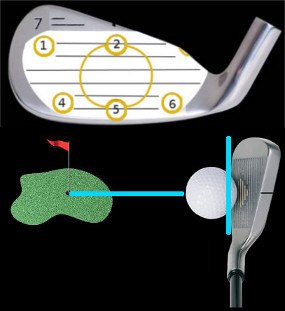
Check Club Face and Sole for Clues to Swing Problems
You should be looking for help in your golf game from any possible source. Golf is a difficult game, and you can never have too much information about your swing and where it may be going wrong. Since you can't actually see your swing while playing on the course, you need to turn to other options for input. Asking your playing partners to watch your technique may help, but that method is limited to the technical knowledge possessed by your friends. As a better choice, consider checking both the club face and sole of the club for clues to any swing problems you may have in your game.
This is a technique which can work on the course, but only when the ball and the ground happen to leave marks on your club which you can review. More likely, you are going to use this method of review on the driving range. There, you can apply tape to your clubs – more on that later – to ensure that markings are left at impact. Based on the information those markings provide, you will be able to make adjustments to your swing to get your game as a whole back on track. This might sound like a complicated, complex approach to take, but it is actually quite simple once you learn the basics.
Of course, if you don't want to go through the trouble of learning how to check your club face and sole for swing clues, you could always opt for the easier route – taking lessons from a golf professional. When you take a lesson from your local pro, he or she will likely check on your impact conditions using things like lie and face tape. Rather than having to learn how to interpret the results on your own, you can trust the pro to help you make the right adjustments to your swing. For those who are short on practice time, turning to the help of a pro make may a lot of sense. Most golf pros offer reasonable rates for their services, and you just may be surprised to find how helpful they can be.
The only notable downside to taking lessons from a pro is the fact that the pro will not be there with you out on the course. So, if you lose your way during an upcoming round after taking a lesson, you won't be able to ask the pro how to get back on track. Should you serve as your own golf teacher, however, you will always know what kind of corrections you need to make in order to fix your ball flight. As the saying goes, knowledge is power. With an intimate understanding of your own swing technique, you can quickly become your own best teacher.
All of the content below is based on a right-handed golfer. If you happen to play left-handed, please take a moment to reverse the directions as necessary.
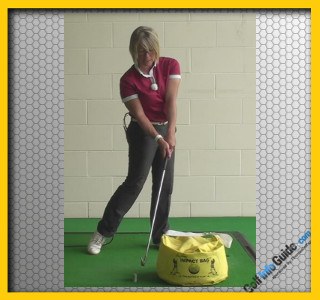
Impact Tells the Story
Checking your club face and sole for clues related to your swing is an effective technique because the moment of impact tells the entire story of your swing. Everything you do from the takeaway all the way through to the finish is designed with one goal in mind – to strike the ball cleanly. If you fail to make good contact, it doesn't matter how pretty the rest of the swing may have been – your shot will be a failure in the end.
While watching a video of your entire swing will always offer you plenty of information on your technique, simply noting your impact conditions based on the face and sole will give you crucial data to interpret. When checking the face, you are obviously going to be looking for the spot on the face where the ball was contacted. Did you successfully hit the sweet spot, or did you miss the shot in off the heel or out on the toe? If you can do a good job of consistently finding the sweet spot at impact, your game is certain to improve. No golfers hit the sweet spot with every swing, but you should strive to get better and better on this point as time goes by.
Moving down to the sole of the club, we are going to again be looking for an impact point. However, rather than hitting the ball, the sole of your club is going to hit the ground. When using lie tape, you can make a mark on the bottom of your club (well, on the tape, technically) and that mark will tell you about the positioning of the head at impact. If you make a mark perfectly in the center of the sole, you will know that the club was flat with the ground at the bottom of the swing. That is the ideal outcome. Unfortunately, many golfers will find that they are hitting the ground with either the heel or the toe first. These less-than-ideal impact positions will make it difficult to hit solid shots, as the face is going to be pointed off-line when you strike the ball.
Fine tuning the quality of your impact position should be one of your top priorities in this game. There are few things you can work on which will be as impactful as improving your impact position, especially when it comes to moving the ball closer to the sweet spot. It is easy to chalk up missing the sweet spot to just random chance, but there is usually an underlying mechanical error involved – specifically when you find a pattern of misses. For instance, if you hit ten balls while checking on your impact with the face, and you find that eight of those shots are missed on the toe, there is almost certainly a mechanical flaw to fix. Take the time to work through your mechanics to iron out any glaring problems and your impact pattern should quickly move in closer to the sweet spot.

How to Check the Club Face and Sole
Now that you understand why it can be helpful to check on these two points on your club after impact, we are going to get into the details of how to actually try this out for yourself. Fortunately, this process is not only easy, it is also quite affordable. You certainly don't need any fancy equipment to check on the quality of your impact through face and sole position, and you don't even need to be an expert in golf instruction. This is something you can easily handle on a DIY basis.
First, let's start by talking about impact position on the face of the club. To check on this element of your swing, you are likely going to want to purchase some 'face tape' (also called impact tape). This product is a paper-like material which you can stick onto the face of any of your clubs (other than the putter). Once in place, face tape will record a mark where the ball contacts the club on each swing. You can use the same piece of tape for several swings, so you can look for any patterns which might develop as you continue to practice. Face tape is available in many golf shops, and you can easily find it on the internet if no golf stores near you have it in stock. It is not expensive, and it is a great thing to store away in your golf bag for occasional use.
To check the way the sole of the club is interacting with the ground at impact, you are going to use a similar process to the process used for checking the face – but you are going to need to add one important step. For the sole, you are going to use 'lie tape', which is a strip of tape that is cut in a shape which will fit the sole of most irons. It is called lie tape because it is used to check on the lie angle that is needed within a set of irons. Just like face tape, you should have no trouble finding lie tape, and it should be pretty cheap to purchase.
The only addition you need to make to the process at this point is a lie board. When you hit your shots using lie tape on the sole of the club, you should be hitting off of a lie board. This is a piece of plastic which is meant to have golf balls hit from it in order to make a mark on the lie tape. If you were to hit shots from the turf, or from a driving range mat, you probably would not find a mark on your lie tape after the swing. The lie board is the piece of the puzzle that brings this process together.
So do you need to purchase a lie board? Probably not. These are pretty basic pieces of plastic, and most golf facilities have a few of them laying around the office. If you ask at the front desk, there is a good chance they will be willing to let you use a lie board during your practice session. If that doesn't work, you may decide to purchase your own – and again, you won't have to spend much money to add one to your collection of golf gear.
Once you have the necessary equipment for this process, all you need to do next is hit some shots. Add some face tape to a few of your irons and hit a collection of shots. Then, place lie tape on the sole of those same irons and hit a few more shots from a lie board. When done, you will have a collection of pieces of tape which tell an interesting story about your ability to strike the ball cleanly. In the sections below, we will get into what exactly you can learn from the story that is told on these pieces of tape.
As a reminder, you can choose to opt for a golf lesson at any point in this process. If you happen to feel like you are really unable to interpret your results properly from the tape, consider talking to the pro at your local golf facility. Any golf professional is going to have a lot of experience reading lie and face tape, so they should be able to help you make the most of the information in front of you. The investment you would have to make in a golf lesson or two will be well worth it if your game takes a big step forward in the weeks and months ahead.
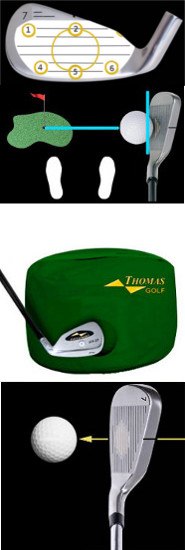
Impact Problems on the Face
Now that you have hit your shots and you are looking down at the pieces of tape in front of you, what are they telling you? To get the most out of this process, you need to take the time to make some logical conclusions about your game. When talking about the positioning of the strike on the face of the club, there are really four options possible. Each of those four options is highlighted below.
- Missing toward the toe. This is a common mistake for amateur golfers. If the ball is contacting the face of the club toward the toe, you will know that there is a mistake which needs to be corrected. It is often the case that the golfer is pulling away from the ball through impact when the shot is missed toward the toe. The upper body gives up on the shot, the head looks up at the target too early, and the sweet spot misses the ball as a result. The fix here is as simple as watching the ball through impact and not anticipating what is going to happen when the ball sails off into the distance. By training yourself to stay down properly through impact and into the follow through, those toe hits should find their way back closer to the sweet spot.
- Missing toward the heel. Obviously, this is the other problem that you can have in terms of missing to the right of left of the sweet spot. When the ball comes in closer to the heel of the club, you will have to worry about the potential for a shank. You don't even want to think about that problem, but it exists if you are missing on the heel. It is possible that you are releasing the club prematurely if you are hitting the ball in anywhere near the hosel. Do your best to hold your angle in the downswing, only using your right hand to propel the club through impact at the last possible moment. Not only will using your lag properly enable you to find the sweet spot, it will also help to straighten out any slice which might be present in your game.
- Hitting the ball high on the face. Most golfers think first and foremost about getting lined up with the sweet spot from a lateral perspective, but you also need to have the club head at the right elevation at impact. If you are hitting the ball high on the face, you may be swinging down into impact with a path that is too steep for the shot at hand. With a steep swing, the club can dig into the ground before it gets all the way through the ball. Counter this mistake by using more shoulder rotation and less hand action in the backswing. Turn your left shoulder under your chin fully as you go back, and keep your hands relatively quiet. This change will level out your swing slightly, and you should no longer be swinging down through the turf so aggressively.
- Hitting the ball low on the face. You certainly saw this one coming. If it is a problem to hit the ball high on the face, it is also an issue to hit the ball low on the face. Rather than swinging down too steep, you are probably too far on the other end of the spectrum when the ball is catching the face near the bottom groove. With a swing that is too shallow, you will struggle to get the club down far enough to find the sweet spot. You may catch the ball cleanly from time to time when you have a good lie, but a poor lie is always going to give you trouble. To steepen your swing plane slightly, add in some extra hand action to the early phase of the swing. Specifically, you want to be setting your wrists before your hands reach hip high on the way back. This movement will place the club head higher in the air, and you will hit down more effectively.
It is important to pay close attention to the results you see when using face tape. The tape doesn't lie in this case – the marks you see on the tape are the spots where you are hitting the ball. Unless you are already doing a great job of hitting the sweet spot, you need to work on quickly making changes to optimize your results. These changes won't always be easy to implement, but they will be worth it in the end.
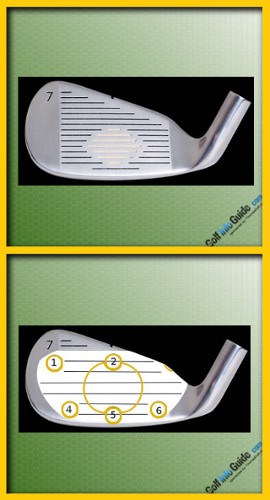
Reading the Lie Tape
Arriving at conclusions when looking at the lie tape is going to be a bit more confusing than when looking at face tape. After all, you know what the goal is with regard to face tape – you want to hit the sweet spot as often as possible. Fortunately, the goal is similar when it comes to lie tape. You want to strike the lie board with the middle of the bottom of your club, time after time. A mark perfectly in the middle of your club indicates that you have the club flat on the ground when the strike occurs.
Of course, you might not be fortunate enough to see a mark in the middle of the club when you test your impact. There are only two possibilities here for how you could be going wrong, and those are listed below.
- Impact toward the toe. If the marks on the sole of your club are toward the toe, the club is too upright at impact. This could be an equipment issue, or it could be a problem with your swing mechanics. One possible swing problem is making the mistake of coming up on your toes prior to hitting the ball. If you force yourself to stand up through impact, your hands will be raised and the toe will hit the ground first. Obviously, the best way to fix this problem is to stay down flat on your feet all the through the hit.
- Impact toward the heel. Again here, you could be dealing with an equipment problem. If your irons are bent to the wrong lie angle, you will have trouble finding the middle of the sole – even if you make a great swing. If it isn't an equipment problem, make sure you are turning through the shot properly on the way down. Players with poor rotation in the downswing will sometimes drop their hands through impact, leading to a heel-first strike.
If you do suspect an equipment problem, ask at your local course about their club fitting services. An iron fitting session should be a relatively quick and straightforward process, and it is usually rather affordable as well. Once the lie angle of your irons is tested against your swing, the club fitter may suggest that your irons be bent either 'up' or 'down', depending on your needs.
Using the face and sole of your clubs to check on your swing might not be the first idea that pops into your mind on the driving range. It is, however, a great idea for the serious golfer. If you want to make sure that you are pursuing all potential avenues for improvement, be sure to pick up some face tape and some lie tape before your next trip to the range. The information you gather through this practice method could help you perform at a higher level for many rounds to come. Good luck!






